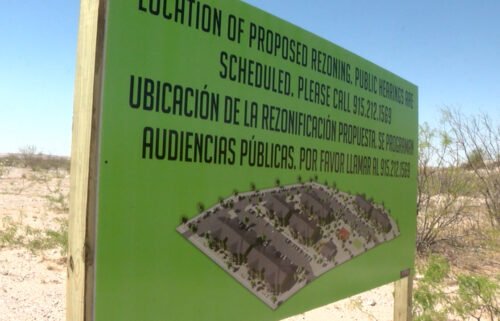Sewage continues flowing into Rio Grande as El Paso Water deals with pipe ruptures
EL PASO, Texas -- Flushing the toilet, taking a shower or using the sink generates wastewater, a process that usually goes forgotten, unless storage and treatment fails — then sewage is often too noticeable.
Several major pipe ruptures mean the wastewater system for parts of west El Paso is inoperable, and El Paso Water is diverting that mostly untreated sewage — an average of 10 million gallons a day — into the Rio Grande until construction on a replacement pipe is completed in December.
El Paso Water Chief Engineering Officer Gilbert Trejo said the system is a series of large pipes buried deep beneath the ground that use gravity to move the wastewater.
Trejo compared the system to the city’s roadways.
“You have your smaller streets which merge into bigger streets. And they just keep combining until you get to like interstate highway, for example. The wastewater collection system works exactly the same way,” Trejo said. “You have the smaller pipes in the street, you get to a larger street and you’ll find the larger pipes and eventually you get to a point where they’re all discharging to a larger pipe main.”
Those large “mains” run deep, about 20 feet below ground. Below that, Trejo said, it’s exceedingly difficult for crews to work on repairs, so the water is then taken to transfer stations, where it’s pumped back up to shallower levels.
The process repeats until the water reaches wastewater treatment sites.
At those plants, water goes through a series of steps before it is fully sanitized. The water is filtered and sieved through granular activated carbon — small pieces of charcoal that trap and remove chemicals — which also helps change taste and remove odors.
Those steps work to filter out large objects and water-borne pathogens. After that, there’s usually a chlorination and chlorination-removal process to kill remaining germs. The John T. Hickerson Water Reclamation Facility on the city’s west side also uses ultraviolet light to sanitize the water it receives from the multiple wastewater treatment sites serving that part of the city.
This reclaimed water is then released into the Rio Grande, or used for irrigating landscapes or cooling off industrial equipment.
Shane Walker, a professor of civil engineering at the University of Texas at El Paso, said using ultraviolet light and chlorine are the two most effective sanitation methods, but not always portable.
An ultraviolet light sterilizer system is “not easily deployable or mobile” to the site of a sewage line break, he said. “Whereas, someone can go out there and dump out those little chlorine pellets.”
Even if El Paso Water had the resources to do something like this, Texas Commission on Environmental Quality guidelines don’t allow releases of chlorinated wastewater into bodies of water.
“Ultimately what you discharge into the river has to be dechlorinated,” Trejo said. “We cannot discharge chlorinated water into the river, or into any water body in the U.S. because you will have an adverse impact on the natural water body.”
Meantime, Trejo said the utility will continue to monitor the impact of sewage on the river.
El Paso Water said it is not currently treating the water put into the river upon orders from TCEQ. Trejo said the utility is using a diluted bleach solution to deodorize and sanitize impacted roads and retention ponds.
Tiffany Young, a spokeswoman for TCEQ, said once El Paso Water completes the repairs and remediation of the pipeline and affected areas, the state agency will “determine if their response” was adequate or if the utility will be cited or fined.
TCEQ did not provide comment regarding negative environmental impacts the agency anticipated in the region or downstream.
TCEQ asked all residents impacted by wastewater spills to contact the complaint hotline or regional office: https://www.tceq.texas.gov/compliance/complaints.

